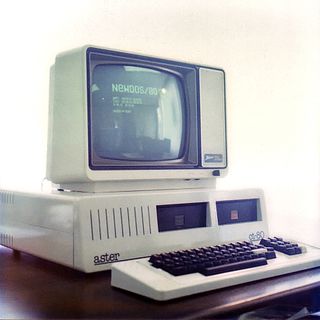
The Aster CT-80, an early (1982) home/personal computer developed by the small Dutch company MCP, was sold in its first incarnation as a kit for hobbyists. Later it was sold ready to use. It consisted of several Eurocard PCB's with DIN 41612 connectors, and a backplane all based on a 19-inch rack configuration. It was the first commercially available Dutch personal/home computer. The Aster computer could use the software written for the popular Tandy TRS-80 computer while fixing many of the problems of that computer, but it could also run CP/M software, with a large amount of free memory Transient Program Area, (TPA) and a full 80×25 display, and it could be used as a Videotext terminal. Although the Aster was a clone of the TRS-80 Model I it was in fact more compatible with the TRS-80 Model III, and ran all the software of these systems including games. It also had a built in speaker which was compatible with such games software.

The Apple II is an 8-bit home computer and one of the world's first highly successful mass-produced microcomputer products. It was designed primarily by Steve Wozniak; Jerry Manock developed the design of Apple II's foam-molded plastic case, Rod Holt developed the switching power supply, while Steve Jobs's role in the design of the computer was limited to overseeing Jerry Manock's work on the plastic case. It was introduced by Jobs and Wozniak at the 1977 West Coast Computer Faire, and marks Apple's first launch of a personal computer aimed at a consumer market—branded toward American households rather than businessmen or computer hobbyists.

The Dragon 32 and Dragon 64 are home computers that were built in the 1980s. The Dragons are very similar to the TRS-80 Color Computer, and were produced for the European market by Dragon Data, Ltd., initially in Swansea, Wales before moving to Port Talbot, Wales and by Eurohard S.A. in Casar de Cáceres, Spain, and for the US market by Tano of New Orleans, Louisiana. The model numbers reflect the primary difference between the two machines, which have 32 and 64 kilobytes of RAM, respectively.

The TRS-80 Micro Computer System is a desktop microcomputer launched in 1977 and sold by Tandy Corporation through their Radio Shack stores. The name is an abbreviation of Tandy Radio Shack, Z80 [microprocessor]. It is one of the earliest mass-produced and mass-marketed retail home computers.

The RadioShack TRS-80 Color Computer, later marketed as the Tandy Color Computer and sometimes nicknamed the CoCo, is a line of home computers developed and sold by Tandy Corporation. Despite sharing a name with the earlier TRS-80, the Color Computer is a completely different, incompatible system and a radical departure in design and compatibility with its Motorola 6809E processor rather than the Zilog Z80 earlier models were built around.

VisiCalc is the first spreadsheet computer program for personal computers, originally released for Apple II by VisiCorp on October 17, 1979. It is considered the killer application for the Apple II, turning the microcomputer from a hobby for computer enthusiasts into a serious business tool, and then prompting IBM to introduce the IBM PC two years later. More than 700,000 copies were sold in six years, and up to 1 million copies over its history.
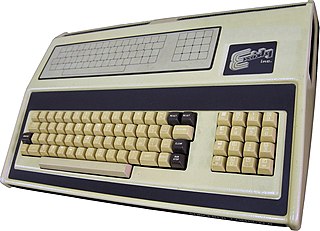
The Sorcerer is a home computer system released in 1978 by the video game company Exidy, later under their Exidy Systems subsidiary. Based on the Zilog Z80 and the general layout of the emerging S-100 standard, the Sorcerer was comparatively advanced when released, especially when compared to the contemporary more commercially successful Commodore PET and TRS-80. The basic design was proposed by Paul Terrell, formerly of the Byte Shop, a pioneering computer store.
Microsoft BASIC is the foundation software product of the Microsoft company and evolved into a line of BASIC interpreters and compiler(s) adapted for many different microcomputers. It first appeared in 1975 as Altair BASIC, which was the first version of BASIC published by Microsoft as well as the first high-level programming language available for the Altair 8800 microcomputer.
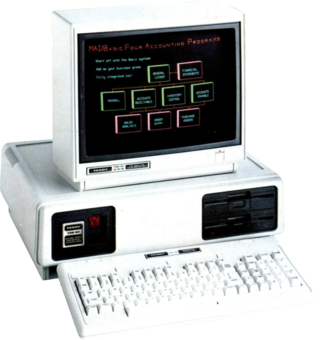
The Tandy 2000 is a personal computer introduced by Radio Shack in September 1983 based on the 8 MHz Intel 80186 microprocessor running MS-DOS. By comparison, the IBM PC XT used the older 4.77 MHz Intel 8088 processor, and the IBM PC/AT would later use the newer 6 MHz Intel 80286. Due to the 16-bit data bus and more efficient instruction decoding of the 80186, the Tandy 2000 ran significantly faster than other PC compatibles, and slightly faster than the PC AT. The Tandy 2000 was the company's first computer built around an Intel x86 series microprocessor; previous models used the Zilog Z80 and Motorola 6809 CPUs.
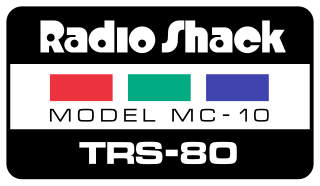
The TRS-80 MC-10 microcomputer is a lesser-known member of the TRS-80 line of home computers, produced by Tandy Corporation in the early 1980s and sold through their RadioShack chain of electronics stores. It was a low-cost alternative to Tandy's own TRS-80 Color Computer to compete with entry-level machines such as the VIC-20 and Sinclair ZX81.
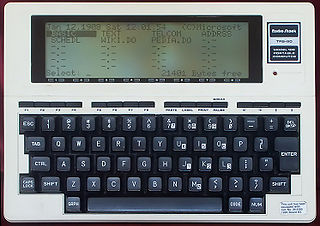
The TRS-80 Model 100 is a portable computer introduced in April 1983. It is one of the first notebook-style computers, featuring a keyboard and liquid crystal display, in a battery-powered package roughly the size and shape of a notepad or large book.

Madness and the Minotaur is a text adventure, published in 1981 for the TRS-80 Color Computer by Radio Shack in North America and by Microdeal in the United Kingdom. It was developed by Spectral Associates founder, Thomas Rosenbaum. A Dragon 32 version was published in 1982 by Dragon Data.

Scripsit is a word processing application written for the Radio Shack TRS-80 line of computers. Versions were available for most if not all computers sold under the TRS-80 name, including the Color Computer and several pocket computer designs, as well as the Tandy version of the Xenix operating system. Tandy Corp. also produced a version running under MS-DOS for its line of PC compatible computers. Some of the 8-bit versions are tape-based and have no ability to read or write to disk.

The TRS-80 Model II is a computer system launched by Tandy in October 1979, and targeted at the small-business market. It is not an upgrade of the original TRS-80 Model I, but a new system.

The TRS-80 Model 4 is the last Z80-based home computer family by Radio Shack, sold from April 1983 through late 1991.

Home computers were a class of microcomputers that entered the market in 1977 and became common during the 1980s. They were marketed to consumers as affordable and accessible computers that, for the first time, were intended for the use of a single nontechnical user. These computers were a distinct market segment that typically cost much less than business, scientific or engineering-oriented computers of the time such as those running CP/M or the IBM PC, and were generally less powerful in terms of memory and expandability. However, a home computer often had better graphics and sound than contemporary business computers. Their most common uses were playing video games, but they were also regularly used for word processing and programming.
Extended Color Basic is an update to the Color BASIC interpreter for the Radio Shack/Tandy TRS-80 Color Computer series and is the default Basic interpreter, for the Color Computer 2. The Color Computer Basic implementations are somewhat different for the versions of Basic which come with the other family of TRS-80 machines, namely Basic Levels I, II, and III. Assemblers and Pascal and C compilers are available for the different machines in the series. Modified subsets of Color Basic may be found on many of the Radio Shack PC series of pocket computers of the era.
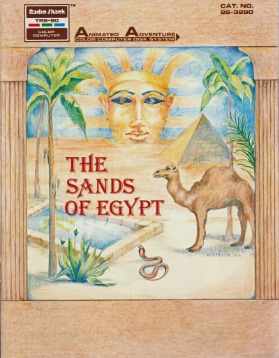
The Sands of Egypt is a 1982 graphic adventure game written by James Garon, Ralph Burris, and Steve Bjork of Datasoft for the TRS-80 Color Computer. It was licensed to Tandy Corporation and was the first disk-only game for the Color Computer sold by RadioShack. Ports to the Atari 8-bit family in 1982 and Apple II in 1983 were published by Datasoft. Set in 1893, the game follows a British explorer and archaeologist who is lost in the desert. Text commands are entered in the lower half of the screen, while a sometimes animated image of the current location is displayed in the upper half.















